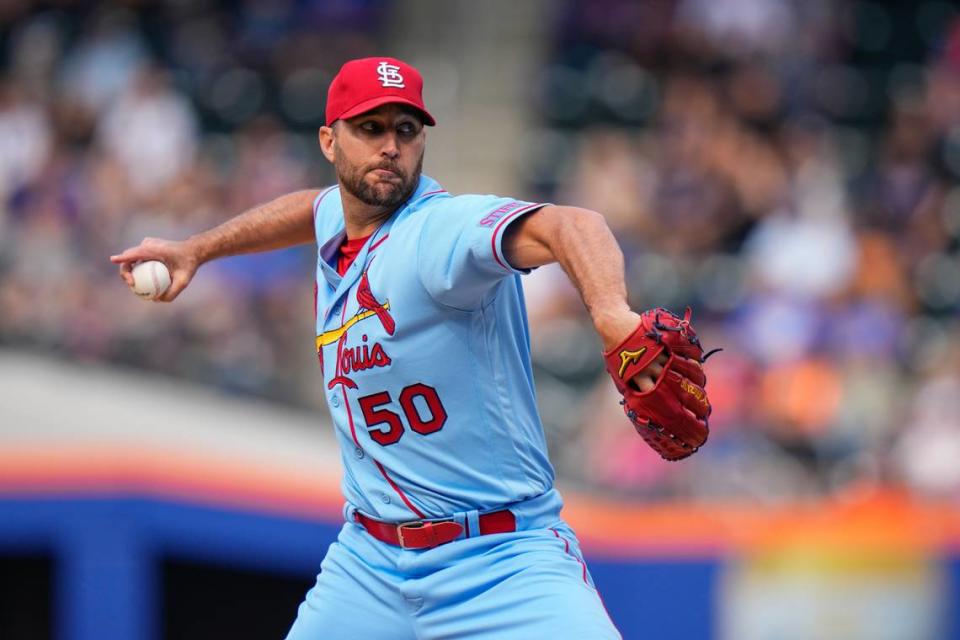Wainwright’s trip to injured list is latest example of mixed messaging from Cardinals
- Oops!Something went wrong.Please try again later.
- Oops!Something went wrong.Please try again later.
- Oops!Something went wrong.Please try again later.
- Oops!Something went wrong.Please try again later.
It’s not Adam Wainwright’s fault that he tried to pitch beyond the point of his physical limitations.
Elite level athletes are wired to compete for as long as the competition is happening and having already lost most of three full seasons to injury, it’s only reasonable to expect he would take the ball as long as it was handed to him.
To stop the inexorable march of futility required leadership of the sort that has been in short supply around the Cardinals during this dreadful season. It shouldn’t be a surprise Wainwright tried so hard; neither should it be a surprise it took so long for him to be stopped.
Wainwright was placed on the injured list Wednesday with a right shoulder strain, just six days after his manager stood at the podium at Busch Stadium and vehemently denied he was pitching with an injury. The tune now is the righty has been dealing with some restrictions for a number of weeks, which is both logical — he’s 41 — and maddening, given the consistent denials.
That uneven messaging is just the latest in an ongoing trend.
Drew VerHagen, placed on the injured list over the weekend, stood at his locker Sunday morning and told reporters soreness in his surgically repaired hip has bothered him for more than a month and that he’s not concerned because his doctors told him to expect an adjustment period after last summer’s surgery to have his labrum reattached.
Oli Marmol, in his office minutes later, said the problem hadn’t been brought to his attention until the previous afternoon when the front office informed him VerHagen was injured after he was barely able to pitch the last inning of a blowout.
Brendan Donovan, on a no-throw program until at least the All-Star break, made a cameo at first base at the end of Tuesday’s 15-2 drubbing by the Marlins. That appearance came in an emergency; the Cardinals lost the designated hitter early in the game after Andrew Knizner absorbed a foul tip beneath his protective cup and Willson Contreras had to slide from DH to behind the plate.
Luken Baker then had to pinch hit in what became the pitcher’s spot, leaving the team and Donovan exposed. He would not, after all, be the first player with an injured arm to play first base at less than full strength. But his manager — in the same conversation with the VerHagen surprise — flatly refused to consider the possibility Donovan might be given such an assignment.
Times change. Truth isn’t always durable. There is a way to handle changing circumstances with aplomb and allow a team to stay as flexible as it needs while still putting out a consistent message.
The Cardinals, to date this season, have not chosen that path.

Staying optimistic no easy task
It would be a lot to expect a team to remain easygoing and optimistic through what is shaping up to be the worst season in nearly three decades. With just 22 games separating them from the trade deadline, the Cardinals would have to play at a 103-win pace over that stretch to be only 10 games below .500 when the deadline comes.
They shouldn’t be expected to admit when it’s over, because that’s also not how things work, especially when a team is stunned not to contend. But as reality closes in, how the team handles the remaining months of the season will reflect how willing those in the clubhouse are to adapt to changing circumstances. Early returns leave reason for doubt.
Nolan Arenado burns hot, but often burns internally. Paul Goldschmidt is not nearly as quiet and austere as his image-shaping would lead one to believe, and he led a team meeting in Chicago in early May that seemed to have an effect. But Goldschmidt can’t be expected to be the loudest player voice every time one is needed.
How far forward can Wainwright feel comfortable placing himself in the midst of his season? How much of his well-documented passion can Willson Contreras pour into others after he spent the first few months of his first season in St. Louis pulling arrows from his back? Knizner is one of the team’s most respected voices and happiest warriors; he’s both hurt and the backup catcher. There are limitations.
What the immediate future might hold
This organization does not know how to lose because they’ve never had to learn, and for that they should largely be thankful. Thrust in the midst of it, though, they’re clearly fighting their way out of the woods without a map. Quicksand, they say, pulls you in deepest when you struggle the hardest, and the Cardinals’ collective heads seem to be just above the morass.
When trades come to strip the roster of pieces — and the trades will come — the struggles might get harder. There is every possibility things will get worse in the short term before they get better. The season has 77 games remaining; it’s on leadership, both in the clubhouse and outside it, to make sure each one has a distinctly less funereal atmosphere.
Wainwright has vowed to return before the end of his final season and pitch effectively. When and if he does, he’ll be celebrated in the way he deserves; if he doesn’t, the celebration will be the same. No one of sound mind feels any differently.
Still, when you see clouds, it doesn’t do anyone any favors to act surprised when the rain starts.

